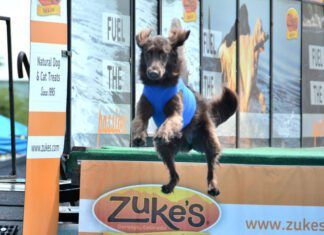Sit is one of the first things many people teach their dogs, and it’s a helpful trick. It’s the foundational skill for a sit-stay and can be used for future impulse control work. You’ll also see sits utilized for exercise in canine conditioning, and a good sit is important for dog sports like rally and obedience, too.
Read on for three different methods you can use to teach your dog to sit.
Step One: Use a Marker and a Reward
Before you can start to teach your dog to sit (or teach her anything for that matter), you need to know how to use a marker system and how to reward. Marking a behavior and rewarding your dog lets your dog know she’s doing the right thing and positively reinforces the behavior you’re looking for.
A marker is a verbal or audible cue that tells your dog the moment they did the correct behavior. It also tells them that a reward is coming their way. Many people use clickers as their marker, but you can also use a word, like “yes,” or make a clicking sound with your mouth. Whatever you decide to use as a marker, make sure you show your dog what it means, and use it often. Remember, if you mark, you have to reward!
To teach your dog what your marker means, you have to “load” your marker. Loading the marker is simple: just click your clicker, say yes, or make a clicking sound with your mouth, and immediately follow up the noise or word by giving your dog a tasty treat. They’ll soon learn that the marker means food is coming.
Now that you understand markers and rewards, here are three ways to get your dog to sit. Play around with each method to find which one works best for your dog.
Method One: Capture a Sit
Capturing is a method of training in which you reward your dog for things they do on their own. We don’t prompt, lure, or ask for anything, we simply mark and reward when it happens organically.
To teach a sit through capturing, you’ll mark and reward every time your dog sits of their own accord. Once you’ve rewarded a behavior multiple times, you can start to add the verbal “sit” cue to it. Say “sit” as your dog starts to sit, then click and reward. Eventually, she will pair the verbal cue with the action of sitting and will do it on cue.
Method Two: Lure a Sit
Luring is a helpful training method because it allows you to manipulate your dog’s position using a treat or a toy. To lure a sit, hold a treat in your hand and put your hand on your dog’s nose. Slowly move the treat up above her head, but don’t move it too high, as she might become disinterested in it. As your dog’s head moves up, her rear will go down. Once her rear hits the floor, you can mark and reward.
When the dog is consistently sitting with the lure, you can add a verbal cue. Say “sit” as you’re moving the lure above your dog’s head. If your dog turns around while you’re luring her, you can also try to lure her into a sit with their back to a wall, so she can’t spin as much.
It will take lots of repetitions for your dog to pair the verbal cue with the action, so stay patient and put in a lot of reps! Don’t forget to fade the lure once your dog understands the verbal cue.
Method Three: Shape a Sit
If your dog doesn’t like to sit or is becoming confused by luring, you can break up the behavior into small steps and reward for incremental steps toward your end goal. This type of training is called shaping.
To shape a sit, follow the same steps you would to lure a sit, but instead of waiting until the dog is sitting to reward her, reward when your dog tilts her head up to look at the treat. Slowly make your criteria harder when the dog is consistently titling her head up. For example, you might next reward her for looking up even further, or for bending her rear legs. Eventually, you raise the criteria so that your dog is sitting with each rep. If your dog fails, go back to the previous step and make your criteria easier.
More Tips for Getting Your Dog to Sit
Never push your dog’s bottom down or pull on her leash or collar to get her to sit. Keep training fun and upbeat, and if your dog is confused, make it easier for them by shaping and rewarding for small steps toward the desired behavior. This makes your dog successful more often, and the more successful they are, the more they’ll want to keep training with you!






